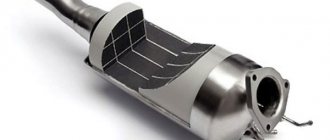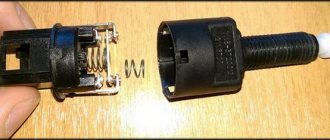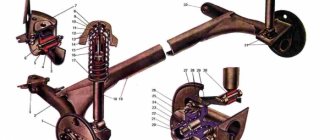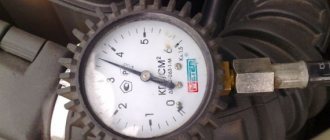Oxygen sensor VAZ 2107 injector
A large number of cars heavily pollute the environment, so the requirements for new cars regarding the content of harmful impurities in exhaust gases are becoming more stringent. They are achieved in different ways, but the most effective is the installation of a catalyst in the exhaust system, as well as adjustment to the optimal composition of the combustible mixture in the engine cylinders. The car’s on-board computer receives a signal from the VAZ 2107 lambda probe, and then, at its command, the composition of the combustible mixture changes.
Why disable the oxygen sensor?
In fact, there is little point in disconnecting the first lambda probe, which is located before the catalyst. He is actively involved in regulating the fuel mixture. If it fails, it is much wiser to replace it with a new one. The only reasonable reason why it makes sense to disable the first oxygen sensor is the use of low quality fuel or operation on gas .
But the second lambda probe, which is located after the catalyst, is turned off in order to remove the catalyst. If you simply remove the catalyst and do not programmatically turn off the second lambda probe, an error will inevitably light up, the engine will go into emergency mode and fuel consumption will increase.
What is a probe
The oxygen sensor VAZ 2107 injector among car enthusiasts is called a lambda probe (λ probe).
On the VAZ “classic” such devices began to be installed after the appearance of an injector on the engine. The lambda probe monitors the presence of oxygen residues in the exhaust gases. This is necessary to reduce the amount of carbon monoxide in the exhaust of a running engine, which is possible after adjusting the composition of the air-fuel mixture in the power supply system of the power unit.
Causes of oxygen sensor malfunction
In most cases, an oxygen lambda operates for about 100 thousand km without failures; however, there are reasons that significantly reduce its service life and lead to malfunctions.
- Oxygen sensor circuit malfunction . Express yourself differently. This may be a complete break in the power and/or signal wires. The heating circuit may be damaged. In this case, the lambda probe will not work until the exhaust gases warm it up to operating temperature. The insulation on the wires may be damaged. In this case, a short circuit occurs.
- Sensor short circuit . In this case, it completely fails and, accordingly, does not give any signals. Most lambda probes cannot be repaired and must be replaced with new ones.
- Sensor contamination with fuel combustion products . During operation, the oxygen sensor gradually becomes dirty for natural reasons and over time may stop transmitting correct information. For this reason, automakers recommend periodically replacing the sensor with a new one, while giving preference to the original, since the universal lambda does not always display information correctly.
- Thermal overloads . This usually happens due to problems with the ignition, in particular, interruptions with it. Under such conditions, the sensor operates at critical temperatures, which reduces its overall service life and gradually disables it.
- Mechanical damage to the sensor . They can occur during careless repair work, when driving off-road, or from impacts during an accident.
- When installing the sensor, use sealants that vulcanize at high temperatures.
- Multiple unsuccessful attempts to start the engine. At the same time, unburnt fuel accumulates in the engine, and in particular, in the exhaust manifold.
- Contact of various process liquids or small foreign objects on the sensitive (ceramic) tip of the sensor.
- Leaks in the exhaust gas exhaust system. For example, the gasket between the manifold and the catalyst may burn out.
Please note that the condition of the oxygen sensor largely depends on the condition of other engine components. Thus, the following factors significantly reduce the life of the lambda probe: unsatisfactory condition of the oil scraper rings, antifreeze getting into the oil (cylinders), and an enriched air-fuel mixture. And if, with a working oxygen sensor, the amount of carbon dioxide is about 0.1...0.3%, then if the lambda probe fails, the corresponding value increases to 3...7%.
Why do sensor failures occur?
Most often, the oxygen sensor in the VAZ 2107 fails after using low-quality fuel; leaded gasoline is especially harmful to it. Other reasons for probe failure may be:
- Presence of fluid in the exhaust system.
- Severely dirty fuel filter.
- Development of the device resource.
Lambda operates in an environment of hot gases, so the ingress of any liquid into its working area will lead to the appearance of cracks and subsequent failure of the device. The on-board computer will not be able to correctly determine the composition of the working mixture. High gasoline consumption will become noticeable, and interruptions in engine operation will occur. Impurities in the fuel do not burn and end up in the exhaust manifold, then on to the lambda, which leads to distortion of its readings.
It is also important to set the ignition correctly, otherwise overheating will damage the device, and pops in the exhaust system will destroy the oxygen sensor and its ceramics. There are cases when “skilled” mechanics break the sensor.
How does an oxygen sensor work?
The main function of the lambda probe is to measure the amount of oxygen contained in the exhaust gases and compare it with the standard.
Electrical impulses from the oxygen sensor enter the electronic control unit (ECU) of the fuel system. Based on these data, the ECU regulates the composition of the fuel assembly supplied to the cylinders.
Installation diagram of the main and additional oxygen sensors in a car
The result of the joint work of the lambda probe and the ECU is the production of a stoichiometric (theoretically ideal, optimal) fuel assembly, consisting of 14.7 parts of air and 1 part of fuel, at which λ = 1. For a rich mixture (excess gasoline) λ 1.
Graph of power (P) and fuel consumption (Q) versus value (λ)
About symptoms of malfunctions
The lambda probe cannot last forever; there comes a time when it becomes unusable. The following signs of malfunction indicate this to the driver:
- Fuel consumption has increased.
- Interruptions in engine operation.
- The car begins to move jerkily.
- Idle speed changes
- The Check Engine light comes on on the dashboard.
The indicator appears when the sensor completely fails. The listed symptoms should alert the driver; they indicate that it is necessary to urgently diagnose the power unit.
Operating principle of a lambda probe
The main task of the lambda probe is to determine the chemical composition of exhaust gases and the level of oxygen molecules in them. This figure should range from 0.1 to 0.3 percent. Uncontrolled excess of this standard value can lead to unpleasant consequences.
During a standard car assembly, the lambda probe is mounted in the exhaust manifold in the area where the pipes connect, however, sometimes there are other variations in its installation. In principle, a different arrangement does not affect the operating performance of this device.
Today you can find several variations of the lambda probe: with a two-channel layout and a broadband type. The first type is most often found on older cars produced in the 80s, as well as on new economy class models. A broadband sensor is typical for modern mid- and high-class cars. Such a sensor is capable of not only accurately determining the deviation from the norm of a certain element, but also promptly balancing the correct ratio.
Thanks to the hard work of such sensors, the vehicle's operating life is significantly increased, fuel consumption is reduced and the stability of idle speed is increased.
From an electrical engineering point of view, it is worth noting that the oxygen sensor is not capable of creating a uniform signal, since this is prevented by its location in the collector zone, because a certain number of operating cycles may pass in the process of reaching the device with exhaust gases. Thus, we can say that the lambda probe reacts rather to destabilization of the engine, which it subsequently notifies the central unit about and takes appropriate measures.
About checking the oxygen sensor
Check the oxygen sensor with a multimeter. The test can be performed as follows: one probe is connected to a white wire, the other probe provides contact with the machine ground. With the ignition on, the multimeter should show a voltage of no more than 0.45 volts. If its readings are greater than this value, the oxygen probe is broken and needs to be replaced. You can also check the resistance of the sensor. To do this, the multimeter should be set to the “resistance measurement” position. Modern sensors have 4 wires for connection. Two white ones are the voltage supply to the heater, blue (may be gray in some models) and black are the signal circuit.
Measure the resistance between the white wires, which must be at least 10 ohms. When it is higher, this indicates a faulty oxygen probe. If you have the necessary equipment, look for the error code. P0131 indicates the presence of a low signal level from the lambda, this occurs due to a lean mixture. To check, you should inject gasoline into the intake tract; if the sensor is working, it will show an enriched mixture. If the error does not disappear, provide air suction. The lambda reaction indicates the serviceability of the device. Signs of malfunctions of the VAZ 2107 injector oxygen sensor have been discussed, now we should talk about replacing it.
Lambda probe sensor pinout table
Purpose
Color combinations for zirconium sensors.
How to check the lambda probe and signs of malfunction? Will a Bosch universal fit?
First of all, when the lambda fails and malfunctions, several tangible consequences appear in the car’s behavior:
Then, to check the lambda probe, you can first unscrew it and carry out a visual check (just as a visual check of the spark plugs can tell you a lot).
Several types of lambdas are installed on cars; the sensors can have one, 2, 3, 4, even five wires, but it is worth remembering that in any of the options, one of them is a signal (often black), and the rest are intended for heater (usually they are white).
How to replace a faulty oxygen sensor
Vehicle diagnostics confirmed that the oxygen sensor is faulty and needs to be replaced. The driver can perform this operation independently. You should purchase a new spare part, prepare the tools, and the place where the faulty oxygen sensor will be replaced. In addition to the new spare part, the driver will need:
- Inspection hole in a garage, overpass or lift.
- Wheel chocks for vehicle wheels.
- Set of tools.
- Liquid WD40.
- Wire brush.
- Rags.
- Work gloves.
You can find out where the oxygen sensor is located on the VAZ 2107 from the vehicle’s operating instructions. It is installed at the bottom of the car on the exhaust pipe. You should only work with the probe on a cold engine, otherwise you can burn your hands or break the sensor itself. The vehicle is installed at the selected work site and the power unit is allowed to cool. The car is braked with a hand brake; for safety, wheel chocks are installed under the wheels.
Next, the process of replacing a faulty probe will be carried out as follows:
- If the bottom of the engine compartment is covered with protection, it must be removed.
- The installation site of the lambda and the sensor itself are cleaned of contamination with a metal brush. Afterwards, the installation site is treated with WD40 liquid.
- While the lead is “working,” cut off the clamps securing the probe wires and disconnect the connector.
- The next step is to dismantle the faulty part. The key is set to “22”, but it may be a different size (depending on the type of lambda), and is turned out of the muffler pipe. You will have to apply some force, since the probe “sticks” in the threaded connection. It is best to use a spanner wrench to avoid tearing off the edges.
- Install a new spare part, connect the connector, secure the sensor wires with clamps.
- Replace previously removed parts in their place.
At this point, the process of replacing the faulty part is completed, you can start the engine and check operation in all modes.
Methods for diagnosing an oxygen sensor
Experts advise checking the correct operation of the lambda probe every 10,000 km, even if there are no problems with the operation of the device.
Diagnostics begins with checking the reliability of the connection between the terminal and the sensor and for the presence of mechanical damage. Next, unscrew the lambda probe from the manifold and inspect the protective casing. Small deposits are cleaned.
If, during a visual inspection, traces of soot, strong white, gray or shiny deposits were detected on the protective tube of the oxygen sensor, the lambda probe should be replaced
How to check a lambda probe with a multimeter (tester)
The sensor is checked for functionality using the following parameters:
Connection diagram to the lambda probe depending on its type
The presence of voltage in the heating circuit is determined with a multimeter or voltmeter in the following sequence:
“+” goes to the sensor from the battery through the fuse. In its absence, this circuit is called.
“—” comes from the control unit. If it is not detected, check the terminals of the lambda probe - ECU circuit.
The reference voltage measurements are carried out using the same devices. Sequencing:
To check the heater, set the multimeter to ohmmeter mode. Diagnostic stages:
Important! The absence of resistance indicates a break in the heater circuit.
A voltmeter or multimeter is used to check the sensor signal. For this:
If during at least one of the checks the indicators differ from the norm, the sensor is faulty and needs to be replaced.
Video: checking the lambda probe with a tester
Checking with an oscilloscope
The main advantage of this lambda probe diagnostic over checking with a voltmeter and multimeter is the recording of the time between similar changes in the output voltage. It should not exceed 120 ms.
Diagnostics with an oscilloscope gives the most complete picture of the operation of the lambda probe
Exceeding the time indicator or crossing the voltage limits of the lower 0.1 V and upper 0.9 V indicates a faulty oxygen sensor.
Video: diagnosing an oxygen sensor with an oscilloscope
Other verification methods
If the car has an on-board system, then the “CHECK ENGINE” signal, which generates a certain error, can be used to diagnose the condition of the lambda probe.
List of lambda probe errors
In order for the lambda probe to work for a long time and efficiently, it is necessary to fill the car only with high-quality fuel. Scheduled and timely diagnostics of the oxygen sensor will help to detect its malfunction in time. This measure can extend the life of not only the sensor itself, but also the catalyst.
How to choose a new oxygen sensor
Retail chains offer a large selection of oxygen sensors, which can be of both domestic and foreign production. The VAZ 2107 has been discontinued, so finding an original spare part is problematic. Finding a replacement for this part will not be difficult, you just need to be careful about your choice, since there are many fakes on the market. First of all, pay attention to the packaging; for fakes it is usually not of very high quality. You should also be wary of the low cost of the part. Spare parts from DENSO, Bosch, Stellox have proven themselves well. Their cost can range from 1500 to 3500 rubles.
Buying an oxygen sensor: original and analogue
There are a large number of different types of sensors on the market. First of all, all products are divided into two categories - original and analogues. Both options have their advantages and disadvantages.
Today it is relatively difficult to find original components. Since the VAZ 2107 car has not been produced for quite a long time.
- Analogs
The market offers a relatively large selection of various analogues of the original sensor. Moreover, both domestic and foreign production. The VAZ 2107 car is relatively simple; parts from many other vehicles fit into it. That is why purchasing an analogue will not be difficult.
But before purchasing a suitable part, it is advisable to carefully study the packaging and the sensor itself. There are many fakes on the market today. Main signs: poor quality packaging, lack of hologram, poorly printed print. Today the following manufacturers have proven themselves to be good:
Purpose and principle of operation of the lambda probe
Lambda probe mounted on the exhaust pipe
Strict environmental requirements for cars force manufacturers to use catalytic converters that reduce exhaust toxicity. But its efficient operation cannot be achieved without controlling the composition of the air-fuel mixture. Such control is carried out by an oxygen sensor, also known as a λ-probe, the operation of which is based on the use of feedback from the device and the fuel system with a discrete or electronic injection system.
The amount of excess air is measured by determining the residual oxygen in the exhaust gas. To do this, the lambda probe is placed in front of the exhaust manifold catalyst. The sensor signal is processed by the control unit and optimizes the air-fuel mixture, more accurately dosing the fuel supply to the injectors. On some car models, a second device is installed after the catalyst, which makes the preparation of the mixture even more accurate.
The lambda probe works as a galvanic cell with a solid electrode made in the form of ceramics made of zirconium dioxide doped with yttria, on which platinum is deposited, which acts as electrodes. One of them records readings of atmospheric air, and the second - exhaust gas.
Oxygen sensor device (lambda probe)
There are two types of λ-probe - broadband and two-point. The first type has higher information content, which allows you to more accurately tune the operation of the engine. The device is made of materials that can withstand elevated temperatures. The operating principle of all types of sensor is the same, and is as follows:
Lambda probe: why an oxygen sensor is so important for a car
Doubtful refueling, bad gasoline, a “check” on the panel - a standard and quick way to replace the oxygen sensor. Many motorists have heard about the lambda probe, but few understood what exactly it is responsible for and why it fails so easily. Let's talk about the oxygen sensor - the "smell" of the engine.
Lambda and engine stoichiometry
The name of the sensor comes from the Greek letter λ (lambda), which denotes the coefficient of excess air in the fuel-air mixture. For complete combustion of the mixture, the ratio of air to fuel must be 14.7:1 (λ=1). This composition of the fuel-air mixture is called stoichiometric - ideal from the point of view of the chemical reaction: the fuel and oxygen in the air will be completely consumed during the combustion process. At the same time, the engine will produce a minimum of toxic emissions, and the ratio of power and fuel consumption will be optimal.
If lambda is 1 (excess air), the mixture is called lean. A mixture that is too rich results in increased fuel consumption and more toxic emissions, while a mixture that is too lean results in loss of power and unstable engine operation.
It is clear from the graph that at λ = 1 the engine power is not peak, and fuel consumption is not minimal - this is only the optimal balance between them. The engine develops the greatest power with a slightly rich mixture, but fuel consumption increases. And maximum fuel efficiency is achieved with a slightly lean mixture, but at the cost of a drop in power. Therefore, the task of the engine ECU (electronic control unit) is to adjust the fuel-air mixture based on the situation: enrich it during a cold start or sharp acceleration, and lean it during uniform movement, achieving optimal engine operation in all modes. To do this, the control unit is guided by the readings of the oxygen sensor.
Why do you need an oxygen sensor?
There are a great many sensors in a modern engine. Using various sensors, the ECU measures the temperature of the outside air and its flow, “sees” the position of the throttle valve, monitors detonation and crankshaft position - in a word, it closely monitors the air “inlet” and engine performance, adjusting the fuel supply to create the optimal mixture in the cylinders .
How to check a lambda probe with a multimeter
When there are jerks when driving, increased fuel consumption, and a lighted “check”, then it is worth carrying out diagnostics. These signs may indicate other malfunctions, but if you have a multimeter, you can check the oxygen sensor yourself. Experts recommend checking the lambda by measuring voltages.
But before any measurements, you need to warm up the internal combustion engine. If the lambda is cold, it will not work. It is also recommended to remove the sensor, if possible, and inspect it and the wiring for dirt or damage. If the sensor is deformed, the electrode is scratched or covered with soot or carbon deposits, then it is better to replace it.
Heating circuit voltage measurements
Turn on the ignition, pierce the wires that go to the heater with probes. You can also plug multimeter probes into the connector. The voltage will be approximately equal to the voltage in the on-board network. If the engine is not running, then there may be no voltage.
Usually the plus comes directly to the heater. The minus is supplied by the control unit. If there is no positive, you should check the circuits from the battery to the sensor. If there is no minus, then you need to check the circuit from the ECU to the sensor.
Heater check
You can check the functionality of the oxygen sensor using an ohmmeter. Very often the breakdown is associated with the heating coil or the wiring to it.
Replacing the oxygen sensor
This small guide will be useful not only to owners of VAZ 2107 cars, but also to more modern tens and fourteeners. Please note that all repair work is best carried out on a lift or inspection pit. Do not forget that the catalytic collector is located in the exhaust gas system. If necessary, dismantle the engine protection of the VAZ 2107. Next, look for all the wires that relate to the oxygen sensor.
All clamps should be cut using wire cutters and the connectors should be disconnected. Moreover, it is advisable to thoroughly clean the one that remains on the machine from accumulated dust and dirt, since it will be used in the future. If the exhaust tract is hot, allow it to cool. Then, using a key with size “22”, unscrew the lambda probe. Screw the new device into place of the old one, tighten the nuts and connect the connection connector. The pinout of the oxygen concentration sensor is shown in the photo.
Source











